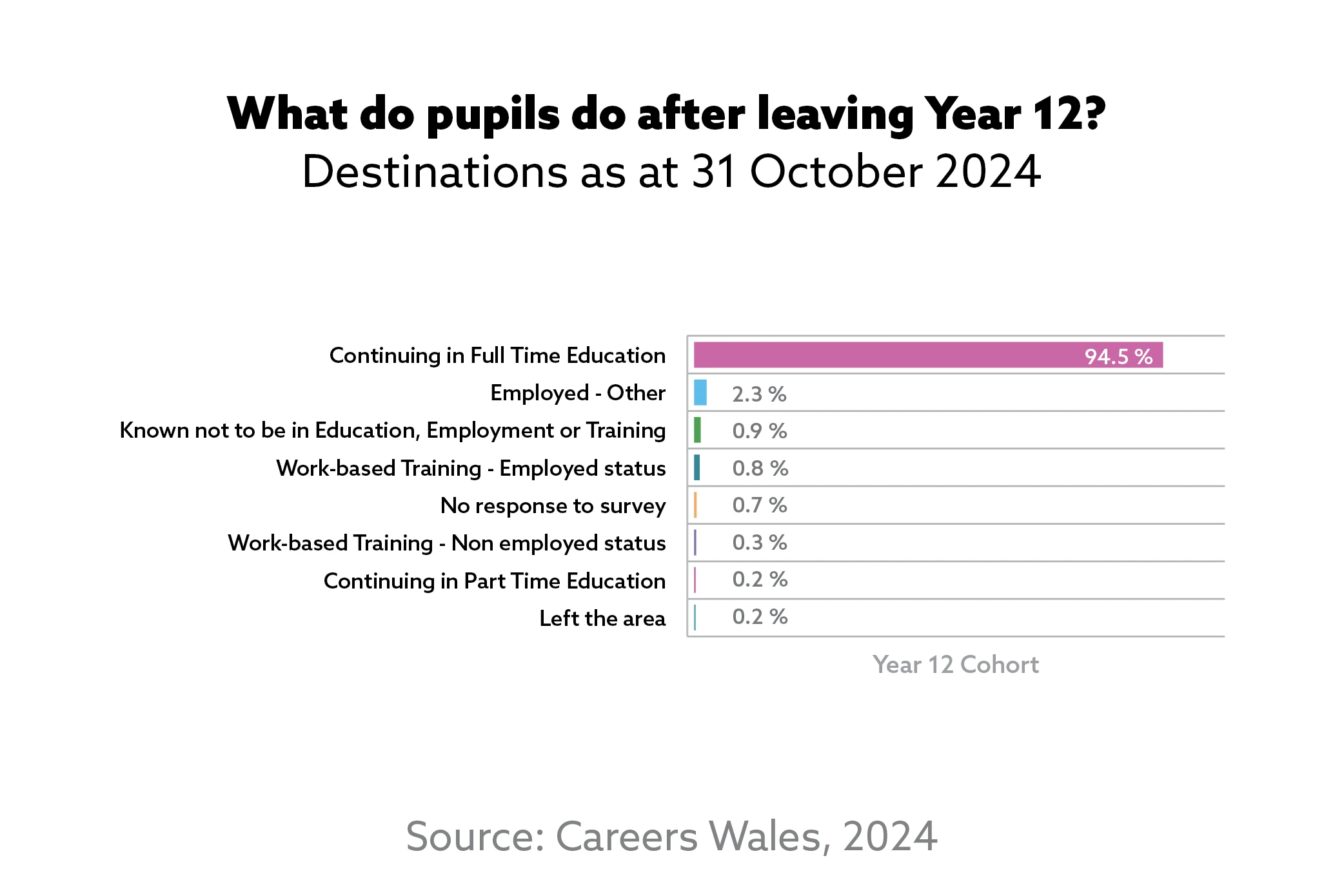Summary
Figures are for students aged 16 or 17 who were in the first year of a school sixth form. The survey, providing the destination of these pupils on 31 October 2024, was in respect of 11,543 pupils.
- Of the Year 12 cohort in 2024, 48.1% (5,548 individuals) were male and 51.9% (5,992 individuals) were female
- The majority of the cohort, 95.8% (11,070 individuals) went into some form of continued learning in full time education (FTE), part time education (16 hours or less a week) or work-based training. This represented 95.4% of male pupils and 96.3% of female pupils
- The greatest proportion of the cohort, 94.5% (10,905 individuals) continued in full time education
- Of those continuing in FTE, 91.6% (9,984 individuals) continued their education in school and 8.4% (911 individuals) continued at a further education college
- A higher proportion of males (10.1%) chose to continue their education at colleges of further education than females (6.7%)
- A higher proportion of females (93.1%) chose to continue to Year 13 in school than males (89.8%)
- 3.4% of the Year 12 cohort (403 individuals) entered the labour market in 2024, either going into employment or work-based training. More males than females chose this route (3.8% males compared to 3.3% females)
- 0.3% of the Year 12 cohort (39 individuals) entered work-based training non-employed status in 2024
- 0.8% of the Year 12 cohort (98 individuals) entered work-based training with employed status in 2024. A higher proportion of males (1.1%) than females (0.7%) chose this route
- 2.3% of the Year 12 cohort (266 individuals) entered employment outside Government supported funding with 2.4% of males (131 individuals) and 2.3% of females (135 individuals) choosing this route
- On the survey date, 0.9% of the Year 12 cohort (100 individuals) were known not to be in any form of education, training, or employment (NEET). Males accounted for 57.0% of the total NEET figure (57 individuals) compared to females at 43.0% (43 individuals)
- Of those known to be NEET, 48.0% (48 individuals) were able to enter employment, education, or training (EET) in 2024 with 52.0% (52 individuals) unable to enter EET due to illness, pregnancy, or other reasons
- The no response rate for the Year 12 cohort in 2024 was 0.7% of the cohort (82 individuals)
- 0.2% of the Year 12 cohort (25 individuals) were shown to have left their local area
Year 12 Overall Figures
| Status | Male | % | Female | % | Other | % | Total | % |
|---|---|---|---|---|---|---|---|---|
| Continuing in Full Time Education | 5,201 | 93.7 | 5,701 | 95.1 | 3 | 100 | 10,905 | 94.5 |
| Continuing in Part Time Education (less than 16 hours a week) | 17 | 0.3 | 11 | 0.2 | 0 | 0 | 28 | 0.2 |
| Work Based Training - Non employed status | 19 | 0.3 | 20 | 0.3 | 0 | 0 | 39 | 0.3 |
| Work Based Training - Employed status | 59 | 1.1 | 39 | 0.7 | 0 | 0 | 98 | 0.8 |
| Employed - Other | 131 | 2.4 | 135 | 2.3 | 0 | 0 | 266 | 2.3 |
| Known Not To Be In Education, Employment or Training | 57 | 1.0 | 43 | 0.7 | 0 | 0 | 100 | 0.9 |
| No response to survey | 51 | 0.9 | 31 | 0.5 | 0 | 0 | 82 | 0.7 |
| Left the area | 13 | 0.2 | 12 | 0.2 | 0 | 0 | 25 | 0.2 |
| Total number in cohort | 5,548 | 100 | 5,992 | 100 | 3 | 100 | 11,543 | 100 |
Full Time Education (FTE)
| Gender | Percentage of students who stayed in Full Time Education |
|---|---|
| Male | 93.7% |
| Female | 95.1% |
| Status | Male | % | Female | % | Other | % | Total | % |
|---|---|---|---|---|---|---|---|---|
| Continuing to Year 13 in School | 4,672 | 89.8 | 5,309 | 93.1 | 3 | 100 | 9,984 | 91.6 |
| Continuing to Year 13 in colleges of further education | 527 | 10.1 | 384 | 6.7 | 0 | 0 | 911 | 8.4 |
| Year 12 continuing in Higher Education | 2 | 0.0 | 8 | 0.1 | 0 | 0 | 10 | 0.1 |
| Year 12 taking gap year with intention of going to Higher Education | 0 | 0.0 | 0 | 0.0 | 0 | 0 | 0 | 0.0 |
| Total | 5,201 | 100 | 5,701 | 100 | 3 | 100 | 10,905 | 100 |
Known Not To Be In Education, Employment, or Training (NEET)
| Status | Male | % | Female | % | Other | % | Total | % |
|---|---|---|---|---|---|---|---|---|
| Able to enter Employment, Education or WBTYP | 31 | 54.4 | 17 | 39.5 | 0 | 0 | 48 | 48.0 |
| Unable to enter Employment, Education or WBTYP due to illness, pregnancy and other reasons | 26 | 45.6 | 26 | 60.5 | 0 | 0 | 52 | 52.0 |
| Total | 57 | 100 | 43 | 100 | 0 | 0 | 100 | 100 |
Ethnicity
Of those returning information on ethnicity:
- The most popular choice of route across those identifying as minority ethnic was continuing in FTE at 96.4%. This is higher than the proportion for those identifying as white (94.3%)
- A higher percentage of those identifying as white went into the various labour market categories (3.8%) compared to those identifying as minority ethnic (1.8%)
- Of young people who were NEET, the same proportion identified as white (0.9% or 87 individuals) as individuals identifying as minority ethnic (0.9% or 12 individuals)
| Status | White | % | Minority Ethnic Groups | % | No information on ethnicity | % | Total | % |
|---|---|---|---|---|---|---|---|---|
| Continuing in Full Time Education (schools and colleges) | 9,372 | 94.3 | 1,309 | 96.4 | 224 | 91.4 | 10,905 | 94.5 |
| Continuing in Part Time Education (less than 16 hours a week) | 18 | 0.2 | 1 | 0.1 | 9 | 3.7 | 28 | 0.2 |
| WBTYP (without employed status) | 29 | 0.3 | 9 | 0.7 | 1 | 0.4 | 39 | 0.3 |
| WBTYP (employed status) | 94 | 0.9 | 4 | 0.3 | 0 | 0.0 | 98 | 0.8 |
| Employment | 254 | 2.6 | 11 | 0.8 | 1 | 0.4 | 266 | 2.3 |
| Known Not To Be In Education, Employment or Training | 87 | 0.9 | 12 | 0.9 | 1 | 0.4 | 100 | 0.9 |
| Unknown | 72 | 0.7 | 8 | 0.6 | 2 | 0.8 | 82 | 0.7 |
| Statutory School leavers who are known to have left the area | 14 | 0.1 | 4 | 0.3 | 7 | 2.9 | 25 | 0.2 |
| Total Number in Cohort | 9,940 | 100 | 1,358 | 100 | 245 | 100 | 11,543 | 100 |
| % of Total Cohort |
| 86.1 |
| 11.8 |
| 2.1 |
| 100 |
View other year groups

View the overall figures of Year 11 pupil destinations from schools in Wales 2024.

View the overall figures of Year 13 pupil destinations from schools in Wales 2024.


